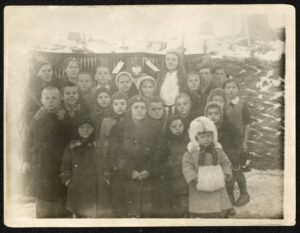
Edmunda Załuska – the “man of trust”(in the middle, wearing a beret with the image of a crowned eagle), Zofia Mojsiejuk (wearing a crown, symbolising Poland), Longin Glijer (last row, 3rd from the left), Ms Markowska (last row, 1st from the left), Weronika Świrniak (last row, 2nd from the left), Stanisława Bojkowska (under the emblem on the left), next to Krystyna Świrniak, Roman Szablowski (third row, 2nd from the left). From the Sybir Memorial Museum collection.
The date of 11 November 1918, the day on which Poland regained its independence, is symbolic. Exactly on that day, an armistice ending the First World War was concluded in a wagon in the forest of Compiègne, but the struggle for the existence of the Polish state was not yet over. It was the events of the First World War and the efforts of the Poles themselves that brought the question of Poland’s independence to the forefront of discussion in Europe. Since 1937, this November day has been a public holiday. It was also celebrated by Poles deported to Siberia.
Krystyna Świrniak, deported with her siblings, mother and grandparents on 13 April 1940 from Kruszewo (Białystok Province) to Kaczyr on the Irtysh (Pavlodar Oblast), was only nine years old at the time. She never forgot celebrating Polish Independence Day in Siberia: “Mum – a patriot, a teacher by profession – taught children and young people our history there. Sixteen to seventeen-year-olds would come to the Polish night talks. I remember how she organised the celebrations of 11 November 1941. Even the photos have survived. They show us hanging a kilim on the dugout, placing a cross and a crowned eagle on top of it. There are two red and white flags. There is a figure in white with a crown on her head, symbolising Poland (our beautiful, then 18-year-old, friend Zosia with her long hair loose and probably wrapped in a sheet). Even now I still have tears in my eyes at the thought of this. Ms Załuska is sitting in the front row wearing a beret adorned with the image of a crowned eagle, my grandmother next to her, and the children are standing further away. It’s freezing cold, everyone is already wearing valenki. Under the eye of the NKVD, we celebrate our Independence Day (…).” From 1945 to 1989, Independence Day was not celebrated – there was no room for it in the communist regime. But for more than 30 years now we have once again revived the memory of the time when we regained our state.



